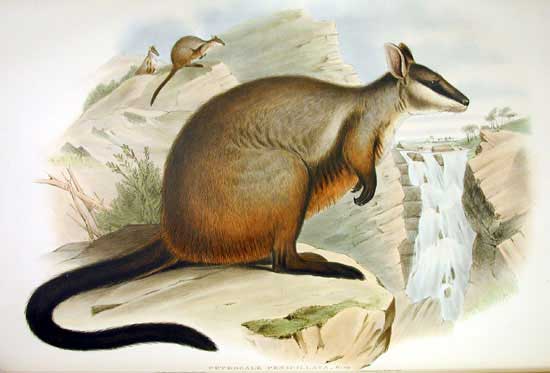Brush-tailed Rock-wallaby (Petrogale penicillata) - Wiki {!--붓꼬리바위왈라비--> Brush-tailed Rock-wallaby
From Wikipedia, the free encyclopedia
[Photo] Petrogale penicillata. Source John Gould, F.R.S., Mammals of Australia, Vol. II Plate 40, London, 1863 http://www.museum.vic.gov.au/bioinformatics/mammals/images/Pet_pen2.htm Date 1863. Author John Gould
The Brush-tailed Rock-wallaby or Small-eared Rock-wallaby (Petrogale penicillata) is a kind of wallaby, one of several rock-wallabies in the genus Petrogale. It inhabits rock piles and cliff lines along the Great Dividing Range from about 100 km north-west of Brisbane to northern Victoria, in vegetation ranging from rainforest to dry sclerophyl forests. Populations have declined seriously in the south and west of its range, but it remains locally common in northern New South Wales and southern Queensland.
External introductions
As part of the acclimatisation movement of the late 1800s, governor Grey introduced this and four other species of wallabies (including the rare Parma Wallaby) to islands in Hauraki Gulf, near Auckland, New Zealand, where they became well-established. In modern times, these populations have come to be viewed as exotic pests, with severe impacts on the indigenous flora and fauna. As a result, eradication is being undertaken. Wallabies have been removed from Rangitoto and Motutapu Islands, and eradication is ongoing from Kawau Island.
In 2003 some Kawau brush-tails were relocated to the Waterfall Springs Conservation Park north of Sydney, New South Wales, for captive breeding purposes.
Due to an escape of a pair in the 1920s, a small breeding population of the Brush-tailed Rock-wallabies also exists on the island of Oahu in Hawaii.
http://en.wikipedia.org/wiki/Brush-tailed_Rock-wallaby
| The text in this page is based on the copyrighted Wikipedia article shown in above URL. It is used under the GNU Free Documentation License. You may redistribute it, verbatim or modified, providing that you comply with the terms of the GFDL. |
